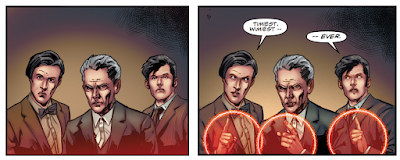 |
| from The Tampa Bay Times |
We've been pretty locked down here since March. I do go out once a week to shop for groceries, and I run the occasional other errand, and of course I teach on campus twice per week, but that's it. Before her maternity leave began, Hayley did teach at her school, but only one of her classes was in person. We took a trip for Thanksgiving, but never came close to other people except briefly outdoors. We had some people over back in October, but everyone stayed six feet apart outside. We have had some visitors since our second son was born, but they were all people who have been pretty careful themselves. That seems like a lot now that I list it out (and I feel like there are a couple things I am forgetting), but it's not much social contact for ten months! And we have been avoiding the major dangers: no eating at restaurants, no large social gatherings, and so on.
So could I have caught COVID? None of us had ever had any symptoms if so. Getting my blood drawn was a pretty painless experience (the researcher: "I've having trouble finding a big vein. Did you drink water this morning?" me: "Only coffee." her: "That's the opposite of what I need!"), and after just under a week I got the e-mail with my results.
I am negative for antibodies.
Hayley asked me if I had wanted to have had it. I thought about this and a couple days later realized, kind of, yes. But not because it would mean I was immune (probably) now. Because it would mean that I was so strong my body had fought it off without me even knowing! As we all know, the strength of your immune system is an indication of your moral fitness.
Back in November, I started to realize I could hear the noise wherever I went.
I don't know exactly when I first noticed it; sometime over the summer, I think. In quiet moments, sitting on the living room couch after Little Buddy had gone to bed, I would hear a faint (I thought) electronic whine. I assumed it was a lightbulb (the lightbulbs above the living couch burn out every six months, so clearly there is some kind of issue there) or maybe my computer's charger or something. I couldn't hear it most of the time, so I didn't worry about it.
But in November, I started to realize that I was always hearing that noise, whether I was sitting on the couch or not. So I started paying attention to it, and discovered that it was always with me. A very faint, very high-pitched whine, only in my left ear. It seemed unlikely to me that I had a bad lightbulb in my car and my office and outside, too. I remember I told Hayley about driving up to our Thanksgiving cottage, and she spent the car trip googling tinnitus.
I see my primary care doctor every January just before the semester starts, so I saved the thought until then, though I needn't have bothered, since all he did was say, "go see a specialist."
I did that this past Tuesday. First I had my hearing tested by an audiologist. This was pretty neat; they put you in a soundproof booth with headphones on and play lots of tones and words at you. She said I had some very slight damage in the high frequencies in my left ear.
The physician actually said I had beautiful hearing and he was jealous. And he confirmed that yes, I do have tinnitus. ("Tin-i-tus, or as it's known on the street, ti-nai-tus.") But I don't have significant hearing loss, I don't any related issues like dizziness or vertigo, and basically there is nothing that can be done. He did say a low-salt diet might help, but that otherwise my best bet is to just keep the environment from being too quiet so it doesn't annoy me too much. I should come back if my symptoms got worse, and thankfully we now had a baseline hearing test for me so we could tell if I began to suffer hearing loss.
I have heard of many people where tinnitus impacts their quality of life negatively. (William Shatner got tinnitus during the filming of the Star Trek episode "Arena," as did Leonard Nimoy.) I think it would take a big amplification of the noise for that to happen to me, thankfully, but I will keep an ear out!























 r
r














